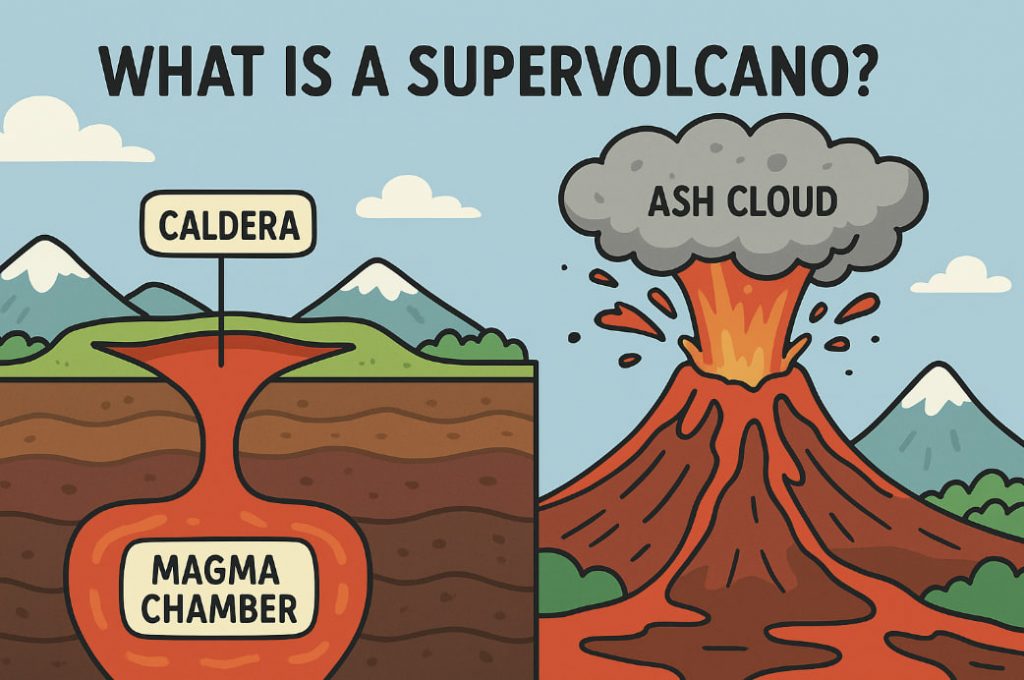Supervolcanoes are massive volcanic systems capable of producing catastrophic eruptions far more powerful than any recorded in human history. Unlike typical volcanoes, which form cone-shaped mountains, supervolcanoes often appear as large calderas — giant depressions in the ground formed after colossal explosions. Although rare, supervolcano eruptions could drastically alter global climate, ecology, and civilization.
What Is a Supervolcano?
A supervolcano is defined by the magnitude of its eruption. Specifically, it must eject more than 1,000 cubic kilometers (240 cubic miles) of material — thousands of times more than a typical volcanic eruption.
These volcanoes don’t always have dramatic peaks. Instead, they may lie beneath lakes, valleys, or flat plains, making them harder to detect without scientific tools.
Notable examples include:
- Yellowstone Caldera (USA)
- Lake Toba (Indonesia)
- Taupō (New Zealand)
- Campi Flegrei (Italy)
- Long Valley Caldera (USA)
How Supervolcanoes Form
- Magma buildup: Over thousands to millions of years, huge magma chambers form in the Earth’s crust.
- Pressure increase: Gas and heat build up under the surface, unable to escape easily.
- Catastrophic eruption: If pressure exceeds the rock’s strength, it causes a massive explosion that empties the magma chamber.
- Caldera collapse: The surface collapses into the void left by the erupted magma, creating a massive depression.
This process can eject ash, rock, and gases across continents and into the atmosphere, affecting the entire planet.
Past Super-Eruptions and Their Impact
- Toba eruption (~74,000 years ago): Possibly caused a volcanic winter that led to global cooling and reduced sunlight for years.
- Taupō eruption (~1,800 years ago): One of the most explosive eruptions in recent history, altering the landscape of New Zealand.
- Yellowstone: Erupted multiple times over the past 2.1 million years, with the largest forming the current Yellowstone Caldera.
Each of these eruptions released enough ash and sulfur dioxide to influence climate patterns, possibly contributing to mass extinctions or human population declines.
What Would Happen If One Erupted Today?
A modern supervolcanic eruption could result in:
- Massive ash fallout, destroying crops, contaminating water, and collapsing buildings across continents
- Global cooling from atmospheric sulfur particles reflecting sunlight
- Disruption of air travel, communication, and supply chains
- Food shortages, economic collapse, and mass migrations
The economic and humanitarian toll could be unlike anything previously experienced.
Are Supervolcanoes Active Today?
Most known supervolcanoes are currently dormant, but not extinct. For example:
- Yellowstone shows seismic activity, ground deformation, and gas emissions — but no signs of an imminent eruption.
- Campi Flegrei is being closely monitored due to recent uplift and underground movement.
Global volcano monitoring programs use seismology, satellite imaging, gas analysis, and ground temperature to track potential warning signs.
Glossary
- Caldera: A large depression formed after the collapse of a volcano’s magma chamber.
- Magma chamber: An underground pool of molten rock beneath a volcano.
- Volcanic winter: A period of global cooling caused by volcanic ash and gases blocking sunlight.
- Sulfur dioxide: A gas that contributes to atmospheric cooling when released in large quantities.
- Dormant volcano: A volcano that is not currently erupting but may become active in the future.


